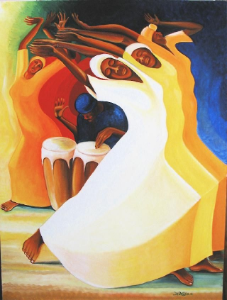

Music, dance and storytelling were the means in which our ancestors preserved their history. The blacks race's history was based in oral traditions and the keepers of these traditions were griots and bards.
More about Yoga
All the Gentiles races had their own form of this practice though it was not called Yoga. The Asians such as the Chinese have utilized Qigong, Tai chi and related practices, the Aryans and East Asians performed what we generally know as Yoga and the Blacks specifically identified with dance.
Dancing and body movement were performed by all the Gentiles races in some way or form. All of these emphasized total body awareness, union within the mind body and soul, developing physical strength and capability as well as achieving a spiritual state of being.
Traditional African dance is powerful and physical and depends on coordination and synchronization within body. Its utilizes the concepts of polyrhythms in which the shoulders, chests, pelvis, arms and legs may move with different rhythms in the music, and total body articulation and isolation of parts of the body.
The traditional movements also include, depending on the dance, hip and rhythmic gyrations of the back and lower spine,movement of the hips to open up the hip centers, body shaking, movements of the cranial with knees bent (as seen in many asian spiritual practices such as Qigong) and foot stomping.
With further observation of the dances, I have seen many similarities between yoga and the traditional dances such as use of mudras, rolling of the neck, the cobra pose, spinal twists, the warrior pose and other yogic positions but this is performed while maintaining constant movement of the body. The movements range from simple and regal to complex and fast. This takes control and connection.
One wonderful example of this is the African dance called the Yanvalou. It originated in West Africa and was brought over to Haiti during the Trans-Atlantic african slave trade along with many other traditional and african pagan religion.
The Voodoo based practices today in Haiti and in some parts of the Americas was derived from the official Vodun religion based on the wisdom of the Serpent, in Africa. VoodooThe Yanvalou is a Vodun dance that invokes and calls upon the all important serpent/snake deity called Damballah who brings upon wisdom and purity. Damballa is another name for the kundalini serpent.
Yanvalou dance is said to be one of the most important of the Vodun based dances and is usually performed before ritual. The dance consists of spinal twists and manipulations, Contractions of the solar plexus, undulations of the back from the base of the spine upwards while knees slightly bent and releasing of the chest. This mimics the movements of the serpent or theIn speaking of the kundalini and of spiritual energy being invoked through movement, In Nigeria during Yoruba ceremonies, many describe their progress of their shamanistic dancing culminates in a surge of heat rising from the base of the spine.
The Kalahari Bushmen in Namibia, also speak of vital spiritual energy which they call N'um. They call it the vital energy residing at the base of the spine and bursts out of the crown of the head. They are said to enter a trance and then 'heat' and stir the energy up through dancing and they channel it for their shamanic healing rituals.
In Africa, the drum has a spiritual significance as well. It aids in ritual and dancing. Dance and music along with the rhythm of the drum are inseparable expressions. The beating of the drums facilitate awareness and helps to induce trance. As the vibrations of the drums permeate the body, altered states are achieved. The music and dance work to entrain the body and entrance the mind into a personalized and vibrationally conscious state.
R
esearch has even demonstrated that energetic rhythms cause the brain to synchronize and helps to balance the cerebral hemispheres. This makes much sense in that the africans used this energy to also mimic primordial energy and go along in tapping into their own divine energies. One Vodun practitioner calls the drum playing as 'beating the spirits into the head'.In my experience in african dance, namely the Yanvalou, It keeps my spine supple and flexible and my body worked out. I like to practice this before my meditations. It is a specific dance with which I equate with a different form of kundalini yoga. I also find that I get an energy buzz after the dancing and so it is an enjoyable way for me to begin my other practices. I love african dancing as it is very fun, freeing and groovy!
Sources:
Daniel, Yvonne "Dancing Wisdom" 2005
Bynum, Edward "The African Unconsciousness" 2012
Welsh-Ashanti "African Dance" 2004
*photo by Bernard Hoyes
Copyright 2024
Blacks for Satan; All rights reserved.